Articles
All Saints Sunday – A Time of Baptism
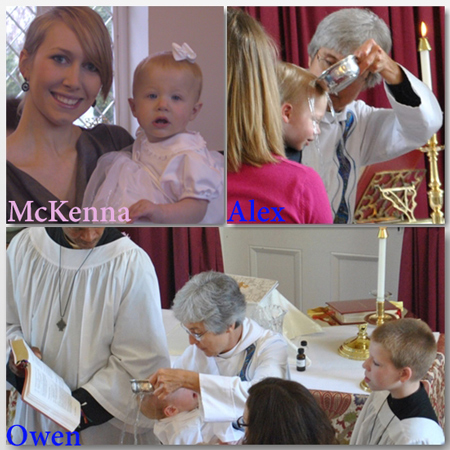
- McKenna Long – Jan. 2, 2011
- Alexander Long VI – Nov. 4, 2012
- Owen Long – Aug. 4, 2013
Baptism of Scarlett Joy Long is on Nov. 1, 2015. Congratulations! Baptism is one of the sacraments of the Episcopal Church and is one of the times of the year appointed for baptism.
Here are the 3 Whys of Baptism
Veterans’s Day, Nov. 11


1. “Let Us Beat Swords into Plowshares”
2. “Tragedy of War”-Michael LaPalme
Veterans’ Day, November 11
At the 11th hour on the 11th day of the 11th month of 1918, World War I (called the Great War) ends.

On November 11, 2018 at the beginning of the worship service, we along with many Americans will toll bells in remembrance of those who served and sacrificed.
From a Litany for Veterans by Robb McCoy-“God of love, peace and justice, it is your will for the world that we may live together in peace. You have promised through the prophet Isaiah that one day the swords will be beaten into plow shares. Yet we live in a broken world, and there are times that war seems inevitable. Let us recognize with humility and sadness the tragic loss of life that comes in war. Even so, as we gather here free from persecution, we may give thanks for those that have served with courage and honor. ” Here is an English Veterans’ Service.
All gave some, Some gave all.

While the US has “Veterans’ Day” celebrating and honoring all veterans who have served, Europe and Canada has “Remembrance Day” about the end of World War I on November 11, 1918. The red remembrance poppy has become a familiar emblem of Remembrance Day due to the poem “In Flanders Fields”. These poppies bloomed across some of the worst battlefields of Flanders in World War I; their brilliant red color became a symbol for the blood spilled in the war.
Mark Knopfler wrote “Remembrance Day” about this day. The song and illustrated slideshow are here .
From “Remembrance Day”
“Time has slipped away The Summer sky to Autumn yields A haze of smoke across the fields Let’s sup and fight another round And walk the stubbled ground
“When November brings The poppies on Remembrance Day When the vicar comes to say May God bless everyone Lest we forget our sons
“We will remember them Remember them Remember them”
Robert Frost “October”

October
Photo Gallery of early fall color, Oct., 2016
Early Fall
Early Fall(full size gallery)
Fall is a wonderful time to pause and look at nature all around you. You have to take the time and not think of the minutes. The time before church is my time to let nature envelop me.
The effect of fall is magnified after a rain. Add another plus for leaves beginning to fall around you in all their color. It’s the sound of the crunching of leaves beneath your fee. It’s a time to look at those small things along the ground- small flowers, water pellets on leaves. It’s time to lookup to see fall advancing in our trees. So many things we never notice or take the time to see.
Water is life giving – and destructive. The effect of rain was seen this week along the gravestones, often with leaves falling around. The wet leaves along the ground reflect up at you. Then over the river to see the water rushing along as I am trying to be still.
Fall is a time to get out Robert Frost for yet another fall.
October
By Robert Frost
“O hushed October morning mild,
Thy leaves have ripened to the fall;
Tomorrow’s wind, if it be wild,
Should waste them all.
The crows above the forest call;
Tomorrow they may form and go.
O hushed October morning mild,
Begin the hours of this day slow.
Make the day seem to us less brief.
Hearts not averse to being beguiled,
Beguile us in the way you know.
Release one leaf at break of day;
At noon release another leaf;
One from our trees, one far away.
Retard the sun with gentle mist;
Enchant the land with amethyst.
Slow, slow!
For the grapes’ sake, if they were all,
Whose leaves already are burnt with frost,
Whose clustered fruit must else be lost—
For the grapes’ sake along the wall”
Request for Names for All Saints Sunday, Nov. 5, 2023
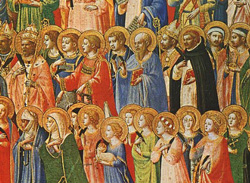
We remember those who have died on All Saints Sunday, Nov. 5 since the last All Saints Sunday.
If you have a name you would like to submit, please email Catherine by Mon., October 30.
Teaching Touchstones for All Saints Adult Formation
- God with Actual Human People
One of the most beautiful messages that All Saints’ Day brings to light is that God is truly with us in our actual humanity. By inviting Christians to perceive ourselves as saints, this feast calls us to understand that our embodied human lives are completely intertwined with God’s sacred presence because God has chosen to be in relationship with us. God’s presence with us doesn’t suppress or subtract our humanity; instead, God embraces all our humanity—limits, graces, imperfections, and all.
Taking our actual embodied humanity seriously in how we talk about saints on All Saints’ Day can open up powerful formation conversations. An image that I find generative for envisioning God with actual human people appears in the book Where God Happens by former Archbishop of Canterbury Rowan Williams. In a discussion about loving a neighbor, he says, “You become a place where God happens.” While he uses this metaphor to describe how an act of love enables a neighbor to encounter God in and through their fellow human being, it also points to the phenomenon of being and becoming saints, actual human beings in relationship with God. Our lives become sacramental places where God shows up for us and with us. If we situate this language in our bodies and humanity, it can liberate us from believing that our bodies, humanity, or identities are hindrances to God and show us how to let God embrace all that we are, “with God’s help,” as we say.
- Holy Together
The Feast of All Saints also points Christians toward the words that we recite in the Apostles’ Creed: “I believe in . . . the communion of saints.” This creedal confession reminds us that our faith is not individual-centered but communal. While the communion of saints often gets described as a mystical body of Christ that unites Christians past, present, and future, this image also suggests that being saints entails being in communion with one another and with God. In this way, All Saints’ Day invites us to recognize that Christians, as members of the communion of saints, are holy together, saints together. God’s Spirit draws us with our differences and diverse experiences into relationships with one another in God, and this togetherness is integral to the sacredness that defines saints’ lives.
- Unknowing
Mystery is another theme of All Saints’ Day—a theme that Jennifer McNally and Anna V. Ostenso Moore note in “What Does This Day Mean? Handout for The Feast of All Saints & All Souls at Home.” When lives of faith take on a sacramental quality and become knit to a communion of saints throughout past, present, and future, we inhabit the mysterious unknowns of God’s ways. We become part of something much bigger than ourselves, and what God may be doing in and through us can surprise and elude us. All Saints’ Day points us toward the mystery that we may be to ourselves and to one another through the incomprehensibility of God’s redemptive and life-giving work among us. It invites us into a simultaneously empowering and humbling posture of welcoming unknowing with God and one another.
One way that we can approach this theme of unknowing is to reflect on our place within the communion of saints. Just as people who came before us have inspired and enriched our lives of faith in ways neither they nor we may fully realize, we don’t know what God will do in future generations through our presence in this communion. This long view of our participation in the movement of God, for whom nothing is lost or beyond redemption, enables unknowing to be a space of hope, solidarity, and courageous, faithful action rather than a source of fear or inaction.
- Love as an Icon of the Holy
All Saints’ Day is certainly about the holy. Holiness, though, can conjure unhelpful images of a punitive God demanding unattainable requirements of absolute submission and sinlessness. What can guide us toward a more life-giving understanding of holiness on All Saints’ Day is love. While John Wesley’s writings first introduced me to this idea, a chorus of scriptures and theologians throughout Christian faith, including I Corinthians 13, Augustine of Hippo, and Julian of Norwich (to name a few), shows us ways of placing love at the center of what holiness means and looks like.
When love becomes our icon of the holy, it expands and transforms our way of being in the world with God and with one another. Being saints becomes first and foremost about letting God love us. Acts of love that may seem small nevertheless forge powerful moments that join people to one another, heal wounds, and endure. Compassion, repair, reconciliation, nonviolence, and spaces held for vulnerability become precious places to seek and find the sacred.
- “Sealed . . . and Marked as Christ’s Own for Ever”
A final theme that All Saints’ Day features is baptism. Because this feast is one of the recommended occasions for baptism, it provides a meaningful opportunity to grapple with the significance of this rite of initiation into the body of Christ. The communal emphasis of All Saints’ Day enables us to pay particular attention to the community we join in baptism. The “not yet” dimension of the communion of saints for us on this side of eternity also helps us tune into the promise of being “sealed by the Holy Spirit and marked as Christ’s own for ever” in baptism (The Book of Common Prayer, 308).
Goodbye, our faithful friend
As most of you know, during September, the Vestry had to make the hard decision to remove our old pear tree behind the parish house. This tree has amazed us through the years by continuing to stand despite a long and ominous crack, and a large hollow in the trunk. The tree had a habit of blooming at odd times of the year. The pear tree’s fruit varied from inedible for all but the yellow jackets and the groundhogs and then this year, a delicious harvest for all.
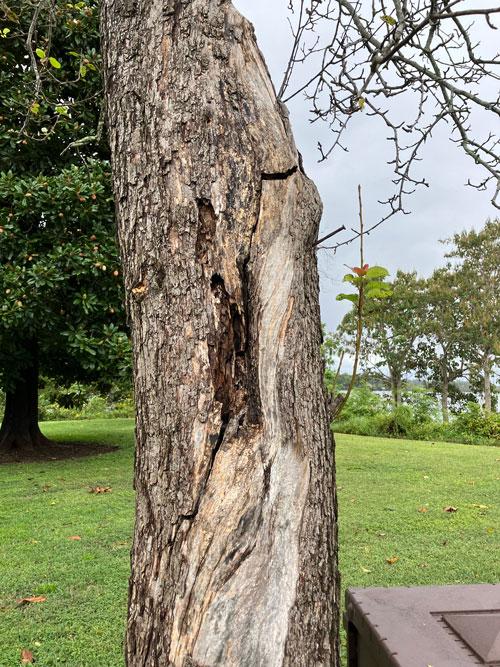
The pear tree was probably planted by the wife of Rev Ware, who served at St Peter’s from 1888 to 1918. She planted an orchard of fruit trees on the church property. This pear tree was probably the last member of her fruit tree orchard, connecting us to the faithful witness of past St Peter’s members.
Our large sycamore tree now stands as a sentinel with no branches. The branches that remained after the freak storm at the end of July did not have enough support from the tree trunk to safely remain on the tree. The sycamore tree will probably bush out in the spring with small branches and leaves. Meanwhile, it too provides a witness to our past.
Gallery of both trees
Stations of the Cross in Holy Week
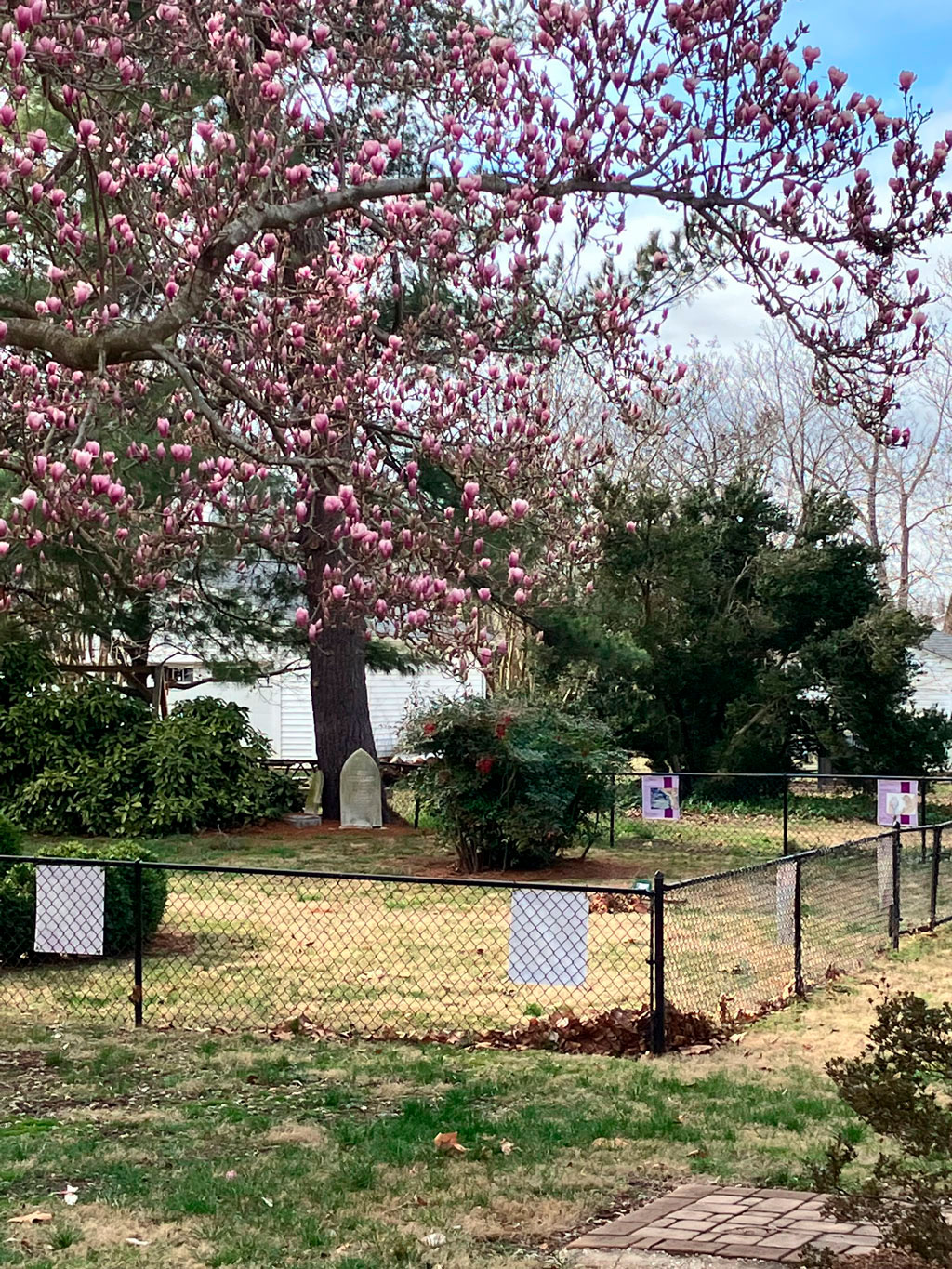 The Stations of the Cross began as the practice of pious pilgrims to Jerusalem who would retrace the final journey of Jesus Christ to Calvary.
The Stations of the Cross began as the practice of pious pilgrims to Jerusalem who would retrace the final journey of Jesus Christ to Calvary.
Later, for the many who wanted to pass along the same route, but could not make the trip to Jerusalem, a practice developed that eventually took the form of the fourteen stations currently found in almost every church. This allowed people to follow the way in their hearts as they meditated on the last hours of Jesus’ life.
Our Stations features 14 paintings of our talented parishioner Mary Peterman and the work of Creative Color in Fredericksburg to create the posters. They are hung outside in our graveyard to increase visibility. Visit it in person or with this link. The images are in order, left to right and top to bottom. Arrows appear on the right (“next) and left (“prev”) to advance the photos.
The stations can be walked in a small group or in solitude. Meditating on the words for each station, and on Mary’s watercolors, will be a spiritual experience that will deepen your relationship to Jesus and your faith.
Walking the stations of the cross also remind us that Jesus lived and died as one of us, and knew horrible suffering. As we travel with him through his last hours, we come to know that Jesus travels with us in our hours of greatest need.
This is the second version of this presentation with better photography. We also have the brochure created by Jan Saylor and the signs in front of the church.
St. Michael and the Angels, Sept. 29

Michaelmas, or the Feast of Michael and All Angels, is celebrated on the 29th of September every year. St Michael is one of the principal angelic warriors, protector against the dark of the night and the Archangel who fought against Satan and his evil angels. It is the “mass of Michael.” As it falls near the equinox, the day is associated with the beginning of autumn and the shortening of days. It used to be said that harvest had to be completed by Michaelmas, almost like the marking of the end of the productive season and the beginning of the new cycle of farming.
World Communion Sunday, Oct. 1

What is World Communion Sunday? Churches this Sunday all over the world celebrate oneness in Christ in the midst of the world ever more in need of peacemaking and the universal and inclusive nature of the church. The tradition originated in the Shadyside Presbyterian Church in 1933, was adopted throughout the US Presbyterian Church in 1936, and subsequently spread to other denominations. The Episcopal Church also remembers students serving abroad, particularly the Young Adult Service Corp in the Episcopal Church.
Poem for World Communion Sunday
THE TABLE WITH NO EDGES by Andrew King
We will sit down where feet tire from the journey.
We will sit down where grief bends the back.
We will sit down under roofs wrecked by artillery.
We will sit down where cries sound from cracked walls.
We will sit down where heat beats like hammers.
We will sit down where flesh shivers in cold.
We will sit down where bread bakes on thin charcoal.
We will sit down where there is no grain in baked fields.
We will sit down with those who dwell in ashes.
We will sit down in shadow and in light.
We will sit down, making friends out of strangers.
We will sit down, our cup filled with new wine.
We will sit down and let love flow like language.We will sit together at the table with no edges.
We will sit to share one loaf, in Christ’s name, in one world.
Climate Change, More Book, Part 3 Reduce, Sept. 24
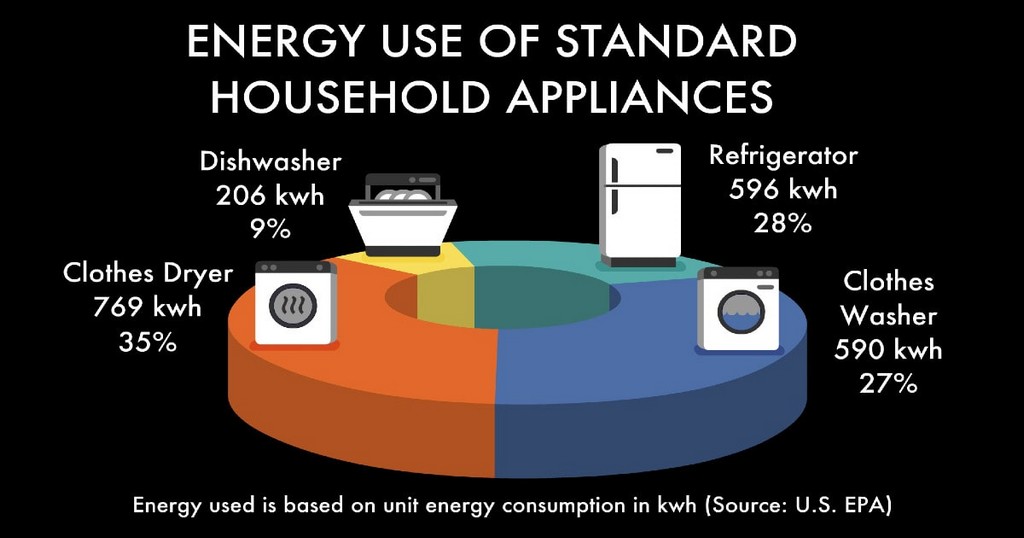
The first two chapters of the MORE book were required material to get to Part 3 – Reduce.
Understanding the significance of our need to reduce greenhouse gases from Part 1, led to calculate our carbon footprint in Part 2. We meet to strive towards net zero emissions by 2050. Net zero means cutting greenhouse gas emissions to as close to zero as possible, with any remaining emissions re-absorbed from the atmosphere, by oceans and forests for instance. Part 2 focuses on reduction to get to net zero.
How much do we need to reduce our carbon footprints? For Americans, that number is about 90 percent.The United Nations’ intergovernmental Panel on Climate Change (IPCC) has said that if we don’t act now, we’ll be facing the severe effects of a warming planet as early as 2040. One example? 50 million people around the world, will be affected by coastal flooding.
This chapter lists 26+ ways for us to act.
Click this button  on the bottom right of the PowerPoint window to enlarge
on the bottom right of the PowerPoint window to enlarge
Christmas peace

One of the hallmarks of the Christmas story is when the angels appear to the shepherds and proclaim, “Peace on earth,” in Luke 2:14.
Jesus brought about peace, in the most unexpected ways, when he arrived. The Jews, particularly the zealots, wanted a rebellion. They wanted their Savior to overturn the oppressive rule of the Romans and bring about peace in a violent way.
But Jesus had something else in mind. Jesus brings us peace in a number of ways.
First, he gives us inner peace. Because of his work on the cross, we have a chance to receive salvation and be indwelled by the Holy Spirit. This grants us an inner peace (John 14:27). Not only do we have the peace that comes from our assurance of salvation, but we also have the peace of mind knowing God will heal this broken world and will come again.
Second, we have peace with others. We put aside our differences (Galatians 3:28), especially with other believers, because we belong to the same family. We have the same purpose: to let others know about the peace of Christ.
The Hebrew word for peace: Shalom, goes far beyond not fighting with others or peace as we know it. As pointed out in the book Not the Way It’s Supposed to Be, shalom is, in essence, how things are meant to be: a slice of heaven.
The peace of God allows us to look at others through heaven’s eyes and help guide the world to see God’s here and not-yet here kingdom.
Peace from God, biblical peace, allows us to trust in God’s promises (Proverbs 3:5), through restful, tranquil faith, despite the dark, scary world around us.
Reconciliation in the Movies – “Home Alone”

Home Alone is the story of eight-year-old Kevin (Macaulay Culkin) waking up and finding himself home alone. His family and extended family had already left, in haste, for Paris, where they will spend Christmas. At first, it is a dream come true for Kevin. He eats what he wants; watches what he wants; and sleeps where he wants. But he quickly becomes the defender of his home against two goons, Harry (Joe Pesci) and Marv (Daniel Stern) who have their eyes set on Kevin’s home for robbery. Kevin develops a series of traps for the burglars to keep them out. And they work.

The film has at least two streams of reconciliation. In the movie we are reminded of a mothers’ love for her child because she did whatever she had to do to get back to her son – even riding in a truck with a polka band! There is probably a notion in her mind that the family seemed to gang up on Kevin at the beginning from the pizza scene to breakfast. The movie is all about Kevin rising to challenges particularly in defeating the crooks. Kevin has a new appreciation of his family providing warmth, comfort and protection.
Reconciliation – on the “Field of Dreams” baseball field

Iowa farmer Ray Kinsella hears a voice in his corn field tell him, "If you build it, he will come." He interprets this message as an instruction to build a baseball field on his farm. The voice becomes more insistent, until he gives in and builds a baseball diamond, complete with lights for night games and bleachers for spectators on his farm. Then appear the ghosts of Shoeless Joe Jackson and the other seven Chicago White Sox players banned from the game for throwing the 1919 World Series to play the game again. When the voices continue, Ray seeks out a reclusive author to help him understand the meaning of the messages and the purpose for his field.
But the real "He" who was to come is the farmer’s long estranged and now dead father. His father John asks, "Is this heaven?" To which, the farmer responds, "It’s Iowa." In a simple game of "catch" on the field they have a chance to talk, see life from the other’s point of view, and experience forgiveness and a restored relationship. A poignant scene.
Some links:
Preserving Water – 6 things you can do

1 Installing an ENERGY STAR-certified washer,
2 Using low-flow faucets
3 Plugging up leaks,
4 Irrigating the lawn in the morning or evening when the cooler air causes less evaporation,
5 Taking shorter showers and not running sink water when brushing your teeth.
6 Consider using non-toxic cleaning products and eco-friendly pesticides and herbicides that won’t contaminate groundwater.
Identity
What we wear on our hearts should be just as obvious to the world as what we wear on our bodies. Our T shirts may say “Harvard”, but our hearts should say Jesus. Our jeans may say “Levis”, but our hearts should say Jesus.” -Br. James Koester, SSJE
“God wants us to become fully the person he created us to be and not to settle for anything less: to become so alive that when people see us they actually see something of God radiating through us and glorifying God.” – Br. Geoffrey Tristram, Society of Saint John the Evangelist
SSJE is a monastic community of The Episcopal Church & The Anglican Church of Canada.
“St Peters as our rock”
From a sermon Aug 24, 2011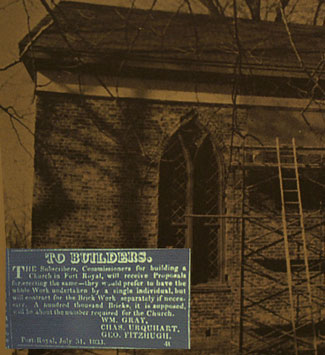
In July of 1833, three of our ancestors here in Port Royal, William Gray, Charles Urquhart and George Fitzhugh, placed an ad in the Virginia Herald for builders.
To Builders— “The Subscribers, Commissioners for building a church in Port Royal, will receive proposals for erecting the same—they would prefer to have the whole work undertaken by a single individual, but will contract for the Brick work separately, if necessary. A hundred thousand Bricks, it is supposed will be about the number required for the church.”
And this church is built of bricks. Bricks, made from the earth itself, are a strong building material, much like rock. In many places in the Old Testament, the rock is a symbol for God.
…Here we are, in a brick church named after St Peter, the man that Jesus called a rock.
And Jesus asks each and every one of us the same question he asked the disciples. “But who do you say that I am?”
When we are able to answer this question as Peter did, “You, Jesus, are the Messiah, the Son of the living God!” we experience a cosmic shift in our lives. When we recognize that God IS the solid core within us—our inner rock.
We profess our faith every Sunday in the words of the Nicene Creed—our belief in God the Father, God the Son and God the Holy Spirit.
But how do we know when God really is at the center of our lives? Paul provides some help with this question in the passage from the letter to the Romans that we heard today. We find that rather than being conformed to the world, we are being transformed by the renewing of our minds. And our minds are made new when we can wake up every morning and hand ourselves over to God. “God, please be the rock in my life today, and please help me serve you by serving my neighbors. Please help me to do whatever it is you give me to do today, to your glory.”
Janine Shepherd – “A Broken Body Isn’t a Broken Person”

Australian Cross-country skier Janine Shepherd hoped for an Olympic medal — until she was hit by a truck during a training bike ride. She shares a powerful story about the human potential for recovery. Her message: you are not your body, and giving up old dreams can allow new ones to soar.
She writes, “The philosopher Lao Tzu once said, “When you let go of what you are, you become what you might be.” I now know that it wasn’t until I let go of who I thought I was that I was able to create a completely new life. It wasn’t until I let go of the life I thought I should have that I was able to embrace the life that was waiting for me. I now know that my real strength never came from my body, and although my physical capabilities have changed dramatically, who I am is unchanged. The pilot light inside of me was still a light, just as it is in each and every one of us.
“I know that I’m not my body, and I also know that you’re not yours. And then it no longer matters what you look like, where you come from, or what you do for a living. All that matters is that we continue to fan the flame of humanity by living our lives as the ultimate creative expression of who we really are, because we are all connected by millions and millions of straws, and it’s time to join those up and to hang on. And if we are to move towards our collective bliss, it’s time we shed our focus on the physical and instead embrace the virtues of the heart.”
This is a wonderful TED Talk. Read the transcript
“Who am I” – Dietrich Bonhoeffer

Dietrich Bonhoeffer was a professing Christian who kept the Christian faith alive during the Adolf Hitler’s rule in Germany. At St. Peter’s we read part of Life Together in Adult Ed.
He was implicated in the bomb plot against Hitler in 1944. Dietrich Bonhoeffer wrote “Who Am I” just one month before he was executed.
“Who am I? They often tell me I stepped from my cell’s confinement Calmly, cheerfully, firmly, Like a squire from his country-house. Who am I? They often tell me I used to speak to my warders Freely and friendly and clearly, As though it were mine to command. Who am I? They also tell me I bore the days of misfortune Equably, smilingly, proudly, Like one accustomed to win.
“Am I then really all that which other men tell of? Or am I only what I myself know of myself? Restless and longing and sick, like a bird in a cage, Struggling for breath, as though hands were compressing my throat, Yearning for colors, for flowers, for the 88voices of birds, Thirsting for words of kindness, for neighborliness, Tossing in expectation of great events, Powerlessly trembling for friends at an infinite distance, Weary and empty at praying, at thinking, at making, Faint, and ready to say farewell to it all?
“Who am I? This or the other? Am I one person today and tomorrow another? Am I both at once? A hypocrite before others, And before myself a contemptibly woebegone weakling? Or is something within me still like a beaten army, Fleeing in disorder from victory already achieved? Who am I? They mock me, these lonely questions of mine. Whoever I am, Thou knowest, 0 God, I am Thine!”
March 4,1946
